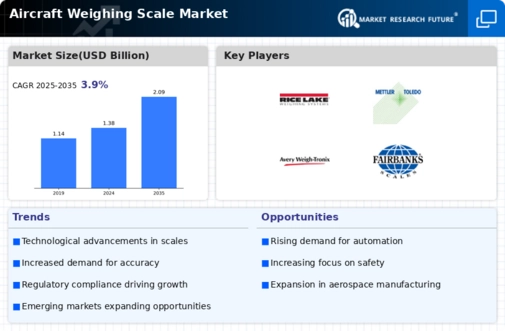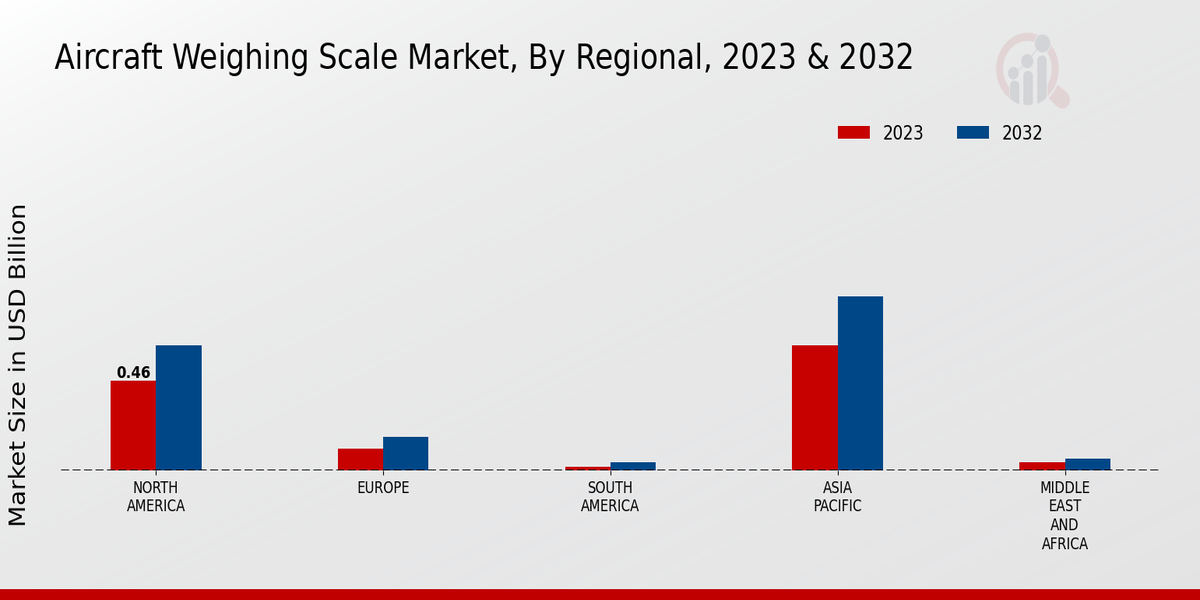Growth of the Aviation Sector
The Global Aircraft Weighing Scale Market Industry is closely linked to the expansion of the aviation sector. As air travel demand increases globally, airlines are investing in new aircraft and upgrading existing fleets, necessitating accurate weight measurements for operational efficiency. This growth is reflected in the projected compound annual growth rate (CAGR) of 3.84% from 2025 to 2035. The rising number of commercial flights and the emergence of low-cost carriers contribute to this trend, as they require precise weight management to optimize fuel consumption and ensure safety. Consequently, the demand for advanced weighing scales is expected to surge, further bolstering the market.
Market Trends and Projections
The Global Aircraft Weighing Scale Market Industry is characterized by various trends that shape its future trajectory. The market is projected to grow from 1.38 USD Billion in 2024 to 2.09 USD Billion by 2035, indicating a robust expansion. The anticipated CAGR of 3.84% from 2025 to 2035 reflects the increasing adoption of advanced weighing technologies and the growing emphasis on safety and compliance in the aviation sector. Key trends include the integration of digital solutions, the rise of automated systems, and the focus on regulatory adherence. These factors collectively contribute to a dynamic market landscape, positioning the Global Aircraft Weighing Scale Market Industry for sustained growth.
Emerging Markets and Globalization
Emerging markets present significant opportunities for the Global Aircraft Weighing Scale Market Industry. As countries develop their aviation infrastructure, the demand for reliable weighing solutions is expected to increase. Globalization has led to a rise in international air travel, prompting airlines to invest in advanced weighing technologies to accommodate growing passenger numbers. This trend is particularly evident in regions such as Asia-Pacific and Latin America, where aviation markets are expanding rapidly. The influx of investments in airport facilities and aircraft fleets in these regions is likely to drive the demand for aircraft weighing scales, contributing to the overall growth of the market.
Increasing Demand for Aircraft Safety
The Global Aircraft Weighing Scale Market Industry experiences heightened demand due to the increasing emphasis on aircraft safety and compliance with regulatory standards. Accurate weight measurements are crucial for ensuring that aircraft operate within their specified limits, thereby enhancing safety during flight operations. Regulatory bodies worldwide mandate precise weight assessments, which drives the adoption of advanced weighing technologies. As a result, the market is projected to reach 1.38 USD Billion in 2024, reflecting the industry's commitment to safety and compliance. This trend is likely to continue as aviation authorities enforce stricter regulations, further propelling the growth of the Global Aircraft Weighing Scale Market Industry.
Regulatory Compliance and Standardization
Regulatory compliance remains a driving force in the Global Aircraft Weighing Scale Market Industry. Governments and aviation authorities impose stringent regulations regarding aircraft weight limits and safety standards. Compliance with these regulations necessitates the use of accurate weighing scales, which in turn drives market growth. The increasing standardization of weighing processes across different regions fosters a uniform approach to weight management in aviation. As regulatory frameworks evolve, the demand for reliable and certified weighing solutions is likely to rise, ensuring that aircraft meet safety and operational standards. This trend underscores the importance of the Global Aircraft Weighing Scale Market Industry in maintaining aviation safety.
Technological Advancements in Weighing Systems
Technological innovations play a pivotal role in shaping the Global Aircraft Weighing Scale Market Industry. The introduction of digital and automated weighing systems enhances accuracy and efficiency in weight measurement processes. These advancements not only reduce human error but also streamline operations, making them more cost-effective. For instance, the integration of wireless technology allows for real-time data transmission, which is increasingly favored in modern aircraft operations. As the industry evolves, the market is expected to grow significantly, with projections indicating a rise to 2.09 USD Billion by 2035, driven by the continuous development of sophisticated weighing solutions.






